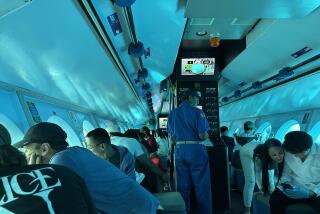The Cutting Edge: COMPUTING / TECHNOLOGY / INNOVATION : Coming Up With New Ways to Dive : Scuba: Ever more sophisticated gear is allowing enthusiasts to go deeper, stay down longer.
- Share via
SAN FRANCISCO — When recreational scuba divers strap on an air tank or two, a regulator and a mask for a typical 50- to 100-foot descent into the sea, they’re using technology that has changed little since 1943, when Jacques Cousteau co-invented the scuba apparatus.
But when rescue workers, Navy SEALs, underwater cave explorers and assorted other amateur adventurers assemble their gear for dives hundreds or even thousands of feet beneath the sea, they’re relying on a panoply of high-tech equipment that grows more sophisticated by the day.
“Tech divers are on a mission: They want to go deep; they want to push the envelope of diving,” says Michael Menudo, publisher of AquaCorps magazine, which sponsored a technical-diving conference this week in San Francisco. And just as auto racers refine technologies that later show up in the family sedan, the advances now being honed in the technical diving world will gradually find their way to the recreational diver.
Fundamentally, the goal of the new diving technologies is to enable people to descend deeper and stay down longer. It’s a tricky business: Every 33 feet of water depth exerts pressure equal to the atmospheric pressure at the Earth’s surface, which means that at depths greater than 100 feet or so, pressure creates all kinds of problems.
The dangers of deep-sea diving include decompression sickness, commonly called the bends, and nitrogen narcosis, also known as rapture of the deep, a drunk-like sensation that comes from breathing nitrogen under pressure. Even oxygen can become deadly at great depths. Because of these problems, typical recreational dives have been limited to about 120 feet.
But tech divers want to go to 1,000 feet or even deeper. For a long time, that was possible only with hard-shell suits (remember Diver Dan?) that required a large crew in a support boat to move and nourish the diver, and meant the diver had to spend days in a decompression chamber after each outing.
Now, though, there are not only new breeds of hard suits, but also exotic new gas mixtures--which solve some of the pressure problems--and ever-improving “re-breather devices” that allow divers to stay under far longer.
At $750,000 apiece, the new hard suits--also known as Newtsuits--won’t quickly replace the traditional wet suits of sports divers. But because they eliminate the need for decompression and large support crews in a boat, the suits represent a price breakthrough for commercial applications.
The suits, which resemble the Michelin tire boy, are completely self-contained undersea environments, tested to a depth of 1,000 feet. The suit includes rotating pincers for hands and a propulsion system controlled by foot movements. A shoulder-mounted camera allows the diver to capture the whole experience on film. Although a dive in a Newtsuit is not recommended to exceed six hours, the suit has a 48-hour life support system. (One diver noted that the main time limitation has to do with the absence of a bathroom.)
More interesting for recreational divers, perhaps, are the advances in re-breathers. As the name suggests, these devices allow divers to re-use their breath, and thus stay down longer with less equipment and without creating air bubbles.
Re-breathers take advantage of the fact that people’s lungs extract only about 30% of the oxygen available in any given breath. The problem is that an exhalation contains carbon dioxide, which is poisonous in all but minute quantities. A re-breather--typically a 50-pound rectangular pack with four small air bottles and a cylindrical filter--scrubs the CO2 out of the exhalations and sends breathable air back to the diver.
Thus a diver can stay down for many hours, as opposed to just one or so with a standard single tank.
The basic technology of re-breathers has been around since World War II, but even a few years ago they cost $35,000; with recent developments in CO2 scrubbing technology, they’re now available for $5,000, and the price is still dropping.
This still does not solve the problem of oxygen poisoning and nitrogen narcosis at great depths, and that’s where new gas mixes come in. Various combinations with names such as heliox and trimex alter the ratio of gases in normal air and sometimes eliminate some gases altogether to allow much deeper dives.
So pretty soon, you won’t have to be a professional, a millionaire or a maniac to dive long and deep. “Tech divers are driving the market for high-tech gear,” says Dick Long, president of Diving Unlimited International Inc. in San Diego. “That’s pushing the price down and allowing sport divers to get in the game.”
And that represents an enormous potential market: About 5 million scuba sets have already been sold, and 250,000 new divers are being certified every year. Most of them spend at least $1,000 their first year. They may soon be spending even more.


